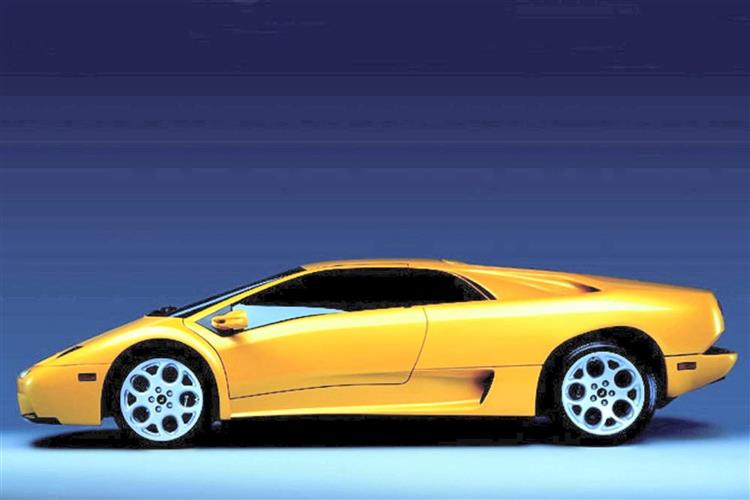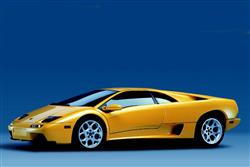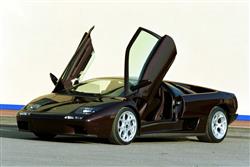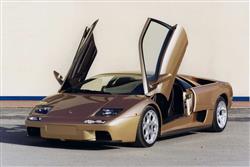THE DEVIL HAS THE BEST TUNES (some text hidden) --NONE--
BY ANDY ENRIGHT
Introductionword count: 102
Few believed that Lamborghini could ever top the Countach, the embodiment of eighties excess. Its successor, the Diablo was at the same time softer edged yet harder hitting, and during its twelve year life span exemplified the state of the supercar art. Always outrageous, always looking for more power, Lamborghini knew that as Ferraris became ever more civilised, they were carving a more secure niche for themselves. A used Diablo will require deep pockets, steady resolve and an owner who can live with its foibles. The definitive supercar? When that V12 bellows in anger, it's about as definitive as you'll ever need.
Modelsword count: 14
Models Covered: (2 dr Supercar 5.7, 6.0-litre petrol [VT, SE30, SV, VT Roadster, GT])
Historyword count: 502
When Lamborghini needed a successor to the Countach, the shortlist of designers was just that. Only one man was approached and the fact that he'd already penned the Miura and Countach ensured that Marcello Gandini's stock was sky high at Sant'Agata. The Diablo was a masterstroke. Launched to an admiring press in Monte Carlo in January 1990, the story behind the Diablo was already convoluted. Gandini's initial sketches were more of an evolutionary Countach style, but paymasters Chrysler had rejected them on the grounds of safety and aerodynamic inefficiency. The softer-edged Diablo was a compromise which worked beautifully. It wasn't until the tail end of 1991 that 'official' UK cars started arriving, all 5.7-litres and 92bhp of them. These were effectively replaced in early 1994 by the all-wheel drive Diablo VT version. Some of the engine internals were also beefed up, the huge fascia binnacle was replaced by a sleeker design, brake ducts appeared in the front spoiler and a lighter clutch and power steering were introduced to make the Diablo that little bit less physical. The two-wheel drive car was withdrawn from sale as all the UK customers now opted for the VT. Perhaps 'all' gives a misleading impression. Portman Concessionaires, the official importers, ran into serious financial difficulties and bit the bullet, leaving an investment in a new Lamborghini looking as wise as shares in Polly Peck. Nevertheless four brave souls took the plunge in 1994. 1995 was a happier year, as Porsche GB took over the reins and did a better job at marketing the Diablo. The 525bhp SE30, built to mark Lamborghini's 30th anniversary 1963-1993, arrived fashionably late in true Lambo style in February 1995. One of these was the notorious Jamiroquai car that was written off in a Chelsea back street. Where the other nine are is anybody's guess. Two versions of an even wilder version of the SE30 called the Jota made it to these shores. These cars boasted no less than 600bhp. The somewhat ungainly Diablo Roadster went on sale in the UK during the summer of 1996 alongside the lightweight Diablo SV. At the start of 1998, the SV's power was upped to 530bhp. ABS was added for the first time along with electronic brakeforce distribution and a driver's airbag. A major cosmetic change came at the end of 1998 when the Diablo's pop-up headlamps were ditched in favour of faired in lights. Most fans approved. At this point the 575bhp Diablo GT was launched, a thinly disguised racing car for the road which, at £195,000 a pop, was the most expensive Lamborghini to date. The final throw of the Diablo dice came with the Diablo 6.0, a 550bhp behemoth produced under the auspices of new owners Audi. The step up in quality is palpable, making the 6.0 the Diablo of choice for the connoisseur, although the Jota remains the pinnacle of rarity. A brown or gold Diablo 6.0 Special Edition was launched shortly before the Diablo was replaced by the all-new Murcielago model.
What You Getword count: 211
All Diablos are spectacularly, almost wilfully, impractical. If you're much over 6'2", the Roadster will be your weapon of choice, as it offers improved headroom. Even 6'7" basketball star Dennis Rodman reckoned he could get comfortable in his and that was with the targa panel in place. The early cars have an interior that's not the last word in sophistication. The huge instrument binnacle wouldn't have looked out of place in a JetRanger helicopter and was the brainchild of Chrysler boss Bob Lutz. Apparently, Lutz wanted the binnacle to move with an adjustable steering column, but engineering this feature was beyond Lamborghini. Later models have a sinuous sweep to the dashboard inlaid with ostentatious lashings of carbon fibre that are far more agreeable. The swing up doors, the stubby bonnet, the V12 roar and the non-existent rear visibility are all Diablo trademarks. The Diablo GT in fact made a feature of the car's lack of rear view by fitting a camera into the rear wing, relaying pictures to a dash mounted monitor. If you were looking for a tip, we'd advise you to opt for the newest car you can afford as a number of developments and teething troubles were gradually ironed out of the Diablo's makeup as time went by.
To see the full road test text contact us on 0330 0020 227
Pictures (high res disabled)


|

|

|
Scoring (subset of scores)
Category: Sporting Cars
| Performance | |
| Handling | |
| Comfort | |
| Space | |
| Styling, Build, Value, Equipment, Depreciation, Handling, Insurance and Total scores are available with our full data feed. | |



